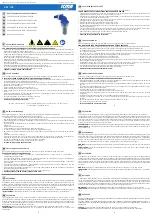
ENGLISH
33
her energy saving is reached by this mode of opera-
tion.
x
Duty/Standby mode:
Each of the two pumps produ-
ces the design delivery rate. The other pump can be
used in the event of the first pump malfunctioning or
following a pump swap. Only one pump operates at a
time.
x
In the event that one pump experiences a
failure/problem,
the other will run as a single pump
in standard mode as instructed by the master.
x
In the event of a
break in communication:
The slave
pump runs at the last set value of the master prior to
the interruption.
x
Pump swap:
If only one pump is operational
(duty/standby, peak- or low-load operation), the
pumps are swapped after every 24 hrs’ actual opera-
ting time.
x
SSM:
The collective fault signal (SSM) of the master
can be connected to a central control point. In this
case, contact is only established with the master. The
reading is valid for the entire unit.
As an option, the error message contacts of master
and slave can be programmed as single fault signal
(ESM) with the IR monitor. For the single fault signals,
contact must be established with each pump.
4.3
Operating the pump
The electronic module (fig. 1, pos. 1) houses the
IR
window
(infrared window, pos.1.1) for communication
with an
IR monitor
and the
LC display
(pos.1.2) with
the
tuning button
(pos.1.3) for operating the pump.
The IR receiver and sender surface must be located in
such a way as to be able to communicate with the IR
monitor. If the connection to the IR monitor has been
made, the
green LED
lights up in the IR window to con-
firm the IR communication of all pumps that were con-
nected to the IR monitor at the same time. The LED on
the pump with which the IR monitor communicates
blinks. It stops blinking 5 minutes after the connection
to the IR monitor has been interrupted. A red
Error
LED
in the IR window lights up when a fault is registe-
red. Information on how to operate the IR monitor can
be obtained in its installation and operating instruc-
tions.
LC display:
The LC display shows the pump’s setting
parameters using symbols and numerical values. The
display can be selected according to the position of the
module, i.e. horizontal or vertical, at a readable angle
(face to face).
The display is constantly lit up. The table below ex-
plains the meaning of the LC display's symbols:
Symbol
Description of possible operating
conditions
auto
Standard mode; automatic switch-
over to night setback mode is
enabled. Night-time mode is acti-
vated at minimum heat output re-
quirement.
auto
Pump runs in night-time mode
(night setback operation) at min.
speed.
(no symb.)
Automatic switch-over to night
setback mode blocked, i.e. pump
runs in standard mode only.
Night setback mode activated via
PLR / LON interface or Ext.Min, re-
gardless of the system tempera-
ture.
Pump runs at max. speed in warm-
up mode. The setting can only be
activated via LON.
Pump switched on.
Pump switched off.
Differential pressure set value set
to H = 5,0 m.
Control system
∆
p-v, regulated to
variable differential pressure set
value (Fig. 8).
Control systemt
∆
p-c, regulated
to constant differential pressure
set value (Fig. 9).
The regulator mode control sy-
stem deactivates the module re-
gulations. The speed
of the pump is kept at a constant
level. The speed is set internally
using the tuning button (Fig. 11).
Pump set to a constant speed
(2.600 rpm in this case) - regulator
mode.
Summary of Contents for Wilo-Stratos -Z
Page 2: ...Fig 1a Fig 1b Fig 2a Fig 3 Fig 2b...
Page 3: ...Fig 5 Fig 4 Fig 6 Fig 7...
Page 4: ...Fig 8 Fig 9 Fig 11 Fig 10 Fig 12...
Page 6: ...Fig 15 Fig 15 LON Fig 15 PLR Fig 15 SBM Fig 15 Ext Min Fig 15 Ext Off...
Page 14: ...DEUTSCH 8 Displaylage horizontal vertikal Lageeinstellung in Men punkt 3...
Page 41: ...ENGLISH 35 Display position horizontal vertical Position setting in menu point 3...
Page 95: ...NEDERLANDS 89 Display richting horizontaal vertikaal Instelling van de richting in menu punt 3...
Page 118: ......
















































